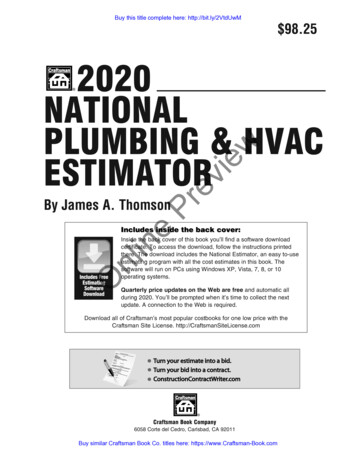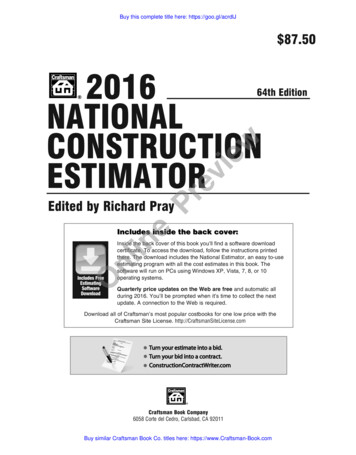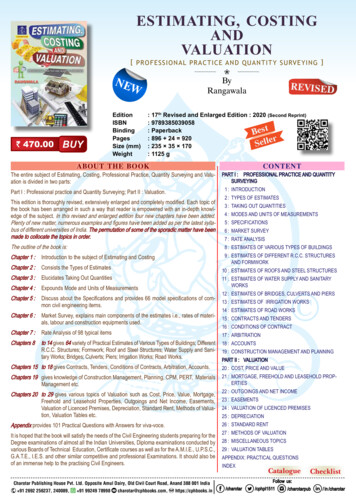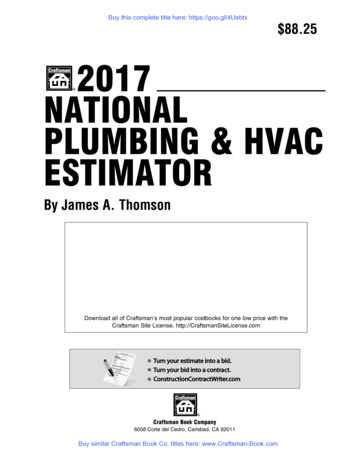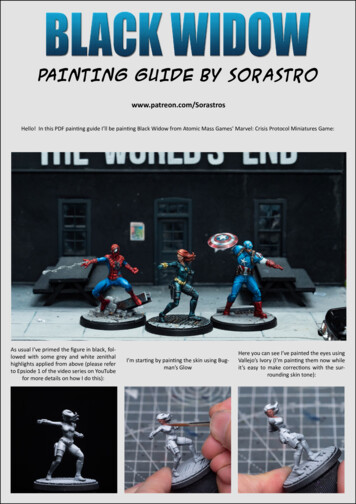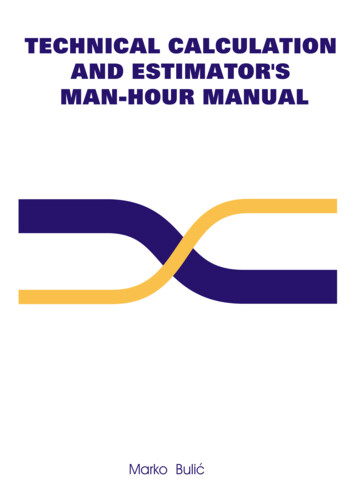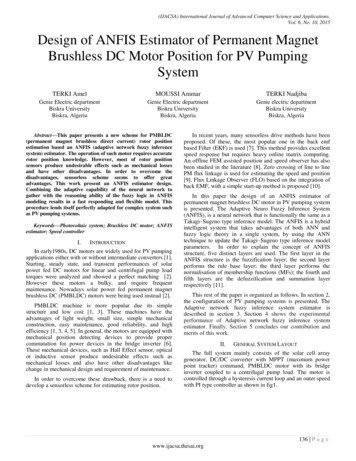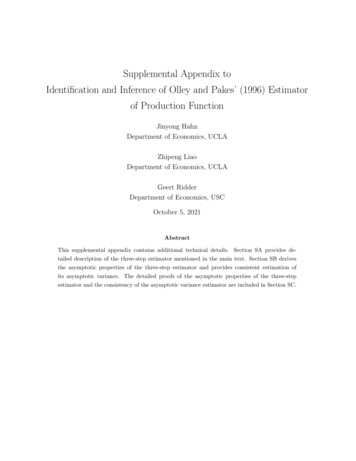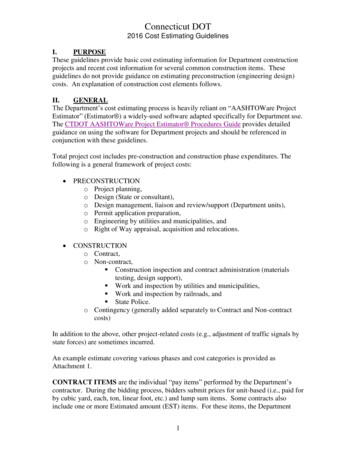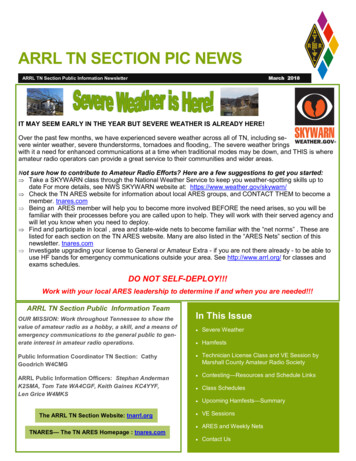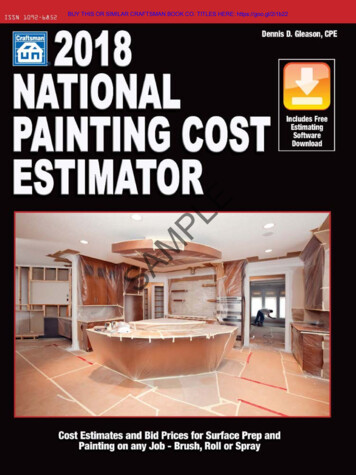
Transcription
SAMPLEBUY THIS OR SIMILAR CRAFTSMAN BOOK CO. TITLES HERE: https://goo.gl/2i1b22
BUY THIS OR SIMILAR CRAFTSMAN BOOK CO. TITLES HERE: https://goo.gl/2i1b22 88.002018NATIONALPAINTING COSTESTIMATORE SAMPLBy Dennis D. Gleason, CPEDownload all of Craftsman’s most popular costbooks for one low price with theCraftsman Site License. http://CraftsmanSiteLicense.comTurn your estimate into a bid.Turn your bid into a contract.ConstructionContractWriter.com Craftsman Book Company6058 Corte del Cedro, Carlsbad, CA 92011
BUY THIS OR SIMILAR CRAFTSMAN BOOK CO. TITLES HERE: https://goo.gl/2i1b22The author thanks the following individuals and organizations for furnishing materials and information used in thepreparation of various portions of this book.SAMPLEHoward Shahan, American Design Painting & Drywall, Poway, CAAmerican Society of Professional Estimators (ASPE), Wheaton, MDBenjamin Moore Paints, San Diego, CAGordon H. Brevcort, Brevcort Consulting Associates, Ridgewood, NJLuis Anguiano, CSI Paint, Napa, CAScott Williams, CSI Paint, San Francisco, and Napa, CAJohn San Marcos, Devoe Coatings, San Diego Marine Hardware, San Diego, CAKen Hogben, Dunn-Edwards Paints & Wallcovering, San Francisco, CARandy Martin, Dunn-Edwards Paints & Wallcovering, La Mesa, CABob Langbein, East Bay Paint Center, Albany, CAHugh Champeny, Kelly-Moore Paint Company, San Carlos, CAEli Dominguez, Kelly-Moore Paint Company, Pleasant Hill, CADennis Cripe, R.W. Little Co, Inc., Sandblasting, San Diego, CAChris Rago, Mark’s Paint Mart, Oakland, CABruce McMullan, McMullan & Son Painting, San Diego, CAJoe Garrigan, Mr. Paints, San Diego, CAPPG Industries, Inc., Pittsburgh Paints, Torrance, CACarlos Jeronimo, PPG Paints, Santa Clara, CAKeith Braswell, Rent-X, Pleasant Hill, CARichardson Engineering Services, Inc., Mesa, AZRust-Oleum Protective Coatings, Los Angeles, CASquires-Belt Material Co., San Diego, CASteel Structures Painting Council, Pittsburgh, PAJohn Meyer, U.S. Government, Department of the Navy, Public Works, San Diego, CAMiguel Govea, Vista Paint Centers, San Diego, CAJerry Rittgarn, Waco-Arise Scaffolding & Equipment, San Diego, CAMark Janson, Warehouse Paint, Auburn, CACover design by: Jennifer JohnsonSheila M. Scott, Calligraphy 2017 Craftsman Book CompanyISBN 978-1-57218-337-7ISSN 1092-6852Published December 2017 for the year 2018
BUY THIS OR SIMILAR CRAFTSMAN BOOK CO. TITLES HERE: https://goo.gl/2i1b22Part I - General Painting CostsAcid wash gutters & downspouts . 296Airblast, compressed air . 296Burn off paint . 297Caulk . 298Cut cracks . 298Fill wood floors . 299Putty, application . 299Sand . 299Sandblast . 302Scribing . 309Strip, remove, bleach . 311Unstick windows. 312Wash . 313Waterblast (Power wash) . 315Window-protective coating . 315Wire brush . 316SAMPLBaseboard . 43Beams . 45Bookcases and shelves . 48Cabinets . 52Ceilings. 57Closets . 88Corbels . 92Cutting-in . 92Decks . 94Doors . 95Fascia . 118Fence . 123Fireplaces . 127Firewood boxes . 128Floors . 129Garage door backs. 137Gutters & downspouts . 138High time difficulty factors . 139Mail box structures . 140Masonry. 140Molding . 153Overhangs . 159Pass-through shelves. 162Plant-on trim . 162Plaster or stucco . 168Pot shelves . 172Railings. 173Registers, HVAC . 182Roof jacks . 183Roofing . 184Sheet metal . 196Shutters or blinds . 201Siding . 202Stairs . 219Touchup, brush as required . 222Trellis or lattice . 223Valances for light fixtures . 224Walls. 225Window screen frames. 276Window seats . 277Window sills . 277Windows . 278Window conversion factors . 292Wine racks. 293Part II - Preparation CostsEIntroduction - How to Use This Book. 5Part III - Industrial, Institutional andHeavy Commercial Painting CostsConduit . 318Decking and siding. 326Doors, hollow metal . 330Ductwork . 331Fire escapes. 348Fire sprinkler systems . 349Grates and grilles . 350Ladders . 354Masonry. 354Mechanical equipment . 356Piping . 357Radiators . 371Structural steel . 372Tank, silo, vessel, or hopper . 400Walls, concrete, tilt-up . 412Windows, steel factory sash . 418Part IV - Wallcovering CostsAdhesive coverage. 422Wallcovering application . 424Borders . 424Flexible wood sheet and veneer . 425Surface preparation, wallcovering. 425Vinyl wallcovering. 426Wall fabric . 430Wallpaper . 434Index . 440
BUY THIS OR SIMILAR CRAFTSMAN BOOK CO. TITLES HERE: https://goo.gl/2i1b22The basis for cost estimates in this book . 6Customize the tables . 7Sandblasting pricing table . 11Pavement marking pricing table . 12Waterblasting pricing table . 13Labor productivity categories . 13Material coverage rates . 15Material price discounts . 16Material prices at 20% discount . 17Material prices at 30% discount . 20Material prices at 40% discount . 23Sundry inventory checklist . 27Hourly wage rates for wallcovering application . 29Labor burden percentages . 30Typical equipment purchase and rental prices . 33Risk factors and profit margin. 36Bidding variables . 36Sample painting estimate . 38Blank painting estimate . 40Interior opening count allowance table. 102Conduit/pipe area conversion table . 325Square corner decking factors . 327Structural steel conversion tables . 391Surface area of spheres . 399Sample field production times and rates form. 419Blank field production times and rates form . 6Title . PageEFigure
enced paint estimator might not be able to do in hours.Instead, this unit cost guide will aid you in developinga good estimate of costs for any painting operation onany project. Think of this manual as one good estimating tool. But it’s not (or at least shouldn’t be) the onlyestimating tool you’ll use.MPLPaint estimating is more of an art than a science.There’s no price that’s exactly right for every job andfor every bidder. That’s because every painting job isunique. No single material cost, no labor estimate, nopricing system fits all types of work. And just as everyjob varies, so do painting companies. No two paintingcontractors have the same productivity rates, the samelabor burden, the same overhead expense and thesame profit requirements.EBUY THIS OR SIMILAR CRAFTSMAN BOOK CO. TITLES HERE: https://goo.gl/2i1b22SAThe best paint estimates are always custom-madefor a particular job. They’re based on the contractor’s actual productivity rate, material cost, labor cost,overhead percentage and profit expectations. No estimating book, no computerized estimating system, noestimating service can possibly account for all the variables that make every job and every painting companydifferent. Only a skilled estimator using professionaljudgment and a proven estimating system can produceconsistently reliable estimates on a wide variety ofpainting jobs.So, Why Buy This Book?That’s easy. This is the most complete, authoritativeand reliable unit cost guide ever made available to paintestimators. No matter what types of work you estimate,no matter what your costs are, this book will help produce consistently accurate painting cost estimates indollars and cents. But it isn’t a substitute for expertise.It’s not a simple way to do in minutes what an experi-For most jobs, I expect that the figures you see herewill prove to be good estimates. But anyone who understands paint estimating will understand why judgmentis needed when applying figures from this manual — orany other paint estimating guide. It’s your responsibilityto decide which conditions on the job you’re biddingare like conditions assumed in this manual, and whichconditions are different. Where conditions are different,you’ll need good professional judgment to arrive at arealistic estimated cost.'18Inside the back cover of this book you’ll find a software download certificate. To access the download, followthe instructions printed there. The download includes theNational Estimator, an easy-to-use estimating programwith all the cost estimates in this book. The software willrun on PCs using Windows XP, Vista, 7, 8, or 10 operating systems. When the National Estimator program hasbeen installed, click Help on the menu bar to see a listof topics that will get you up and running. Or, go onlineto www.craftsman-book.com and click on Support, thenTutorials, to view an interactive tutorial for National Estimator.5
BUY THIS OR SIMILAR CRAFTSMAN BOOK CO. TITLES HERE: https://goo.gl/2i1b22National Painting Cost EstimatoræSlow (1P)Medium (2P)Fast (3P)ManhourproductivityLaborcost st itLow 20.7524.0% 4.98 12%High34.0035.3%12.0046.0040%31.0%7%Notes: These rates are for painters. Hourly rates for wallcovering are different. See page 29. Slow, Medium and Fast jobs are definedon page 13. Labor burden percentages used in this book are summarized on page 31. National Estimator uses hourly rates in the Laborcost plus burden column. National Estimator shows productivity rates (Slow, Medium and Fast) and copies the words Slow, Medium orFast to your estimate. It also copies the crew productivity code, either 1P (Slow), 2P (Medium), or 3P (Fast) to your estimating form.National Estimator allows you to enter any percentage you select for overhead and profit.EFigure 1The basis for painting cost estimates in this bookYour decision on the application rate to use (or whichcombination of rates to use) has to be based on yourevaluation of the job, your painters and your company.That’s where good common sense is needed.PLHow to Use the TablesSAPart I: General Painting CostsPart II: Preparation CostsPart III: Industrial, Institutional andHeavy Commercial Painting CostsPart IV: Wallcovering CostsEach section is arranged alphabetically by operation. If you have trouble finding the tables you need,use the Table of Contents at the front of the book or theIndex at the back of the book.Once you’ve found the right table and the appropriate application method, you have to select the correctapplication rate. For each of the application methods(brush, roll, mitt or spray), the tables show three application rates: “Slow,” “Medium,” or “Fast.” That’s a veryimportant decision when using this book, becauseeach application rate assumes different manhour productivity, material coverage, material cost per gallon,hourly labor cost, labor burden, overhead and profit.6Figure 1 shows crew codes, labor costs, labor burdens, material discounts, and profit for each of thethree production rates for painting.MThe estimating tables in this book show typical costsand bid prices for every painting operation you’re likelyto encounter, whether paint is applied by brush, roller,mitt or spray. Selecting the right cost table and the correct application method is easy. Tables are divided intofour parts:The “Slow” application rate in Figure 1 assumeslower productivity (less area covered per manhour),a lower labor cost (due to a less skilled crew), alower labor burden (due to lower fringe benefits), alower discount on materials (because of low volume),higher overhead (due to lower volume) and a higherprofit margin (typical on small repaint or custom jobs).Figures in this “Slow” application row will apply wherepainters with lower skill levels are working on smalleror more difficult repaint jobs.Look at the “Fast” row in Figure 1. These estimateswill apply where a skilled crew (higher hourly rate andlarger fringe benefits) is working under good supervision and good conditions (more area covered permanhour) on larger (volume discount on materials) andmore competitive jobs (lower profit margin). Figures inthe “Fast” application row assume high productivity andlower material coverage, (unpainted surfaces absorbmore paint), like that of a residential tract job.Each of the three application rates is describedmore completely later in this section.
BUY THIS OR SIMILAR CRAFTSMAN BOOK CO. TITLES HERE: https://goo.gl/2i1b22How to Use This Book¾Pricing variables12LaborMaterialSF per man- coveragehourSF/gallonUnit cost estimate3456789Materialcost pergallonLaborcost per100 SFLaborburden100 SFMaterialcost per100 SFOverheadper100 SFProfitper100 SFTotalcost per100 SFWalls, gypsum drywall, orange peel or knock-down, roll, per 100 SF of wall areaFlat latex, water base (material #5)Roll 1st 0.32EYour customized figuresPLFigure 2Customize the tablesMThe Easy Case: No AdjustmentsSALet’s suppose the “Slow” application rate fits thejob you’re estimating almost perfectly. Your crew’sproductivity is expected to be low. The labor cost willbe 20.75 per hour. Labor burden (fringes, taxes andinsurance) will be 24.0 percent. Discount on materialswill be 20 percent. Overhead will be 19 percent andprofit will be 16 percent. Then your task is easy. All ofyour costs match the costs in the “Slow” row. No modifications are needed. The same is true if your costs fitthe “Medium” or “Fast” rows.But that’s not always going to happen. More often,the job, your crew and your company won’t fit exactlyinto any of the three rows. What then? More evaluationis required. You’ll combine costs from several application rate rows to reach an accurate bid price. I call thatcustomizing your costs and it’s nearly always requiredfor an accurate estimate.This book is designed so you can quickly and easilyadjust estimates to reflect actual costs on the job you’reestimating. It’s important that you read the rest of thissection before using the cost tables in this book. That’sthe only way to get from this manual all the accuracyand flexibility that’s built into it.In the remainder of this section I’ll describe theassumptions I’ve made and the methods I used tocompile the cost tables in this manual. Once you understand them, you’ll be able to combine and modify costsin the estimating tables so your bids fit the job, yourcrew and your company as closely as possible.When you start using the cost tables in this book, Isuggest you circle numbers in the “Slow,” “Medium,” or“Fast” application rate rows that best fit your companyand your jobs. To improve accuracy even more, writeyour own figures in the blank row below the “Fast” rowin each table, like I’ve done in Figure 2.Customizing Your CostsEvery company has a different combination of worker speed and experience, taxes, benefits, spread rates,equipment needs, percentage for overhead, and profitmargin. These are the cost variables in paint estimating.A Practical ExampleFigure 2 is part of an estimating table taken frompage 228 of this book, General Painting Costs. I’m goingto use it to show how to customize estimates to match7
BUY THIS OR SIMILAR CRAFTSMAN BOOK CO. TITLES HERE: https://goo.gl/2i1b22National Painting Cost EstimatorIn column 1, Labor SF per manhour, I’ve circled 675because I feel the journeyman painter assigned to thisjob can paint walls at the “Fast” rate of 675 square feetper hour. That’s the number I plan to use for my estimate.In column 2, Material coverage SF/gallon, I’vereviewed my past performance and I expect coveragewill be about 275 square feet per gallon of paint. So I’vecircled that figure.In column 3, Material cost per gallon, I’ve circled29.80 for my cost per gallon for flat water base latex(including tax and an allowance for consumable supplies), based on a 30 percent discount from the retailprice.In column 8, Profit per 100 SF, I’ve calculated theprofit dollar value by adding the labor cost, labor burden, material cost and overhead then multiplying thatsum by the “Medium” profit at 12 percent from Figure 1.The result is 3.11 .75 10.65 3.63 18.14 x.12 2.18.Column 9, Total cost per 100 SF, is the bid price — it’sthe sum of columns 4 through 8 for each row. BecauseI’ve circled costs that fall in more than one row, I can’tuse any figure in column 9. Instead, I simply add thecircled or calculated figures in columns 4 through 8: 3.11 .75 10.65 3.63 2.18 20.32.That’s my bid price per 100 square feet on this job.It’s the combination of costs that fit my company, mypainters and the job.PLSo far, so good. That completes the first threecoumns, what I call the pricing variables. Now we canbegin on the unit cost estimate, columns 4 through 9.Each of these columns show a price per 100 squarefeet of wall.In column 7, Overhead per 100 SF, I’ve calculatedthe overhead dollar value by adding the labor cost,labor burden and material cost then multiplying thatsum by the “Medium” overhead at 25 percent: 3.11 .75 10.65 14.51 x .25 3.63.Eyour actual costs. In Figure 2 I’ve circled some of thecosts I plan to use in a sample estimate and calculatedothers.Using Your Good JudgmentSAMWe’ll start with column 4, Labor cost per 100 SF.Notice that I’ve entered 3.11 for this column. Here’swhy. Look back at Figure 1 and the “Slow” labor rate at 20.75. (See Figure 13 on page 29 for the wage ratesfor wallcovering.) Since I’m in a part of the countrywhere prices, and wages, are lower than the nationalaverage, my experienced painters work for 21, closerto the “Slow” labor cost, though they produce at the“Fast” rate of 675 SF per manhour. This gives me anadvantage because my labor costs are lower thanthose in Figure 1. To calculate the labor cost per 100SF, divide 21.00 by 675 and multiply by 100: 21/675 .0311 x 100 3.11.In column 5, Labor burden 100 SF, I’ve entered .75.This figure is a result of my labor cost at 3.11 x 24.0percent, my labor burden (taxes, insurance and benefits) from the “Slow” row of Figure 1. Even though thelabor rate is “Fast” and the labor cost is higher than the“Slow” rate, for this example labor burden will be mostlike work done at the “Slow” rate because this companydoesn’t offer many benefits.In column 6, Material cost per 100 SF, I’ve circled10.65, the number in the “Medium” row. Since I’ve usednumbers in the “Medium” row in both columns 2 and3, I can take the figure in column 6 for material costsdirectly from the table, without any calculations.8Of course, judgment is required when using thesetables, as it is when making any estimate. For example,if your journeymen painters earn the top rate of 33.75but work at the “Medium” production rate or slower,your labor cost per unit will be higher than the highestcost listed in column 4. An adjustment will be required.Because figures in columns 7 and 8 are percentages of figures in columns 4, 5 and 6, you have to becareful when you blend costs from different rows. Let’slook at an extreme (and unlikely) example.Suppose you use costs from the “Slow” application row for columns 4 (5.19), 5 (1.24) and 6 (11.13)of Figure 2. The total of those three costs is 17.56.Then you decide to use overhead from the “Fast” rowbecause your overhead is about 31 percent of cost,not 19 percent of cost as in the “Slow” row (Figure 1).“Fast” overhead is listed as 5.21 in Figure 2. The correct overhead figure is 5.44, 31 percent of the sum of“Slow” costs in columns 4, 5 and 6. Be aware of thissmall discrepancy and calculate figures for all the categories yourself if extreme accuracy is essential.
BUY THIS OR SIMILAR CRAFTSMAN BOOK CO. TITLES HERE: https://goo.gl/2i1b22How to Use This BookConverting Unit PricesThe last column in Figure 2 shows the total cost per100 square feet of wall. Some estimating tables in thisbook show a total cost per 100 linear feet (such as forbaseboard) or total costs per unit (such as for doors).To convert a cost per 100 square feet to a cost persquare foot, move the decimal point two places to theleft. Thus the cost per 100 square feet for the “Fast” ratein Figure 2 is 23.55 or about 24 cents per square foot.adjacent surfaces, and do any extensive setup,cleanup, or touchup. (See the discussion ofSURRPTUCU on the next page.)Mobilization or demobilization Supervision Material handling, delivery, or storage Sample preparationGeneral Qualifications Mixing coatingsIt’s important that you understand the conditionsthe tables are based upon. I call these conditions thejob qualifications. A qualifications statement followseach estimating table to help you understand what’sincluded and what’s excluded. Please read thosequalifications before using costs from this manual inyour estimates. The following points apply to all tablesin this book: Excessive material waste or spillage Equipment rental or placement costs Scaffolding rental and erection costs Subcontract costsPLIncluded CostsMMinor preparation, both time and material.Normal preparation for new residential construction is included in the “Fast” row and for newcommercial jobs in the “Medium” row. Minimalpreparation is included for repaint jobs in the“Slow” row.SA Minimum setup and cleanup Equipment such as ladders, spray rigs andbrushes are included in overhead for the “Fast”rate (residential tracts) or “Medium” (commercial)work. Add equipment costs at their rental rate for“Slow” (repaint) jobs.Excluded Costs E Equipment costs such as ladders, spray rigs, etc.for “Slow” (repaint) jobs. Add these at their rentalrate whether or not you own the equipment.Extensive surface preparation. Add the costof time and materials needed for more than“normal”preparation work. Also add time to removeand replace hardware and accessories, protect Contingency allowance Owner allowances Commissions, bonuses, overtime, premium payfor shift adjustments (evening work), travel timeor per diem. Bonds, fees, or permits Additional insurance to meet owner requirements Work at heights above 8 feet or beyond thereach of a wand or extension pole. (See thetable for High Time Difficulty Factors on page139.)Surface PreparationThe Preparation estimating tables that follow Part I:General Painting Costs, apply to both interior and exterior surfaces.Surface preparation is one of the hardest parts ofthe job to estimate accurately. Any experienced paintercan make a reasonably good estimate of the quantity ofpaint and time needed for application. But the amountof prep work needed will vary widely — especially forrepaint jobs. Some will need very little work. Others willtake more time for prep than for painting.9
BUY THIS OR SIMILAR CRAFTSMAN BOOK CO. TITLES HERE: https://goo.gl/2i1b22National Painting Cost Estimator1) Setup includes unloading the vehicle, spreadingthe tarp and setting up the tools — everythingthat has to be done before prep or painting canbegin.Preparation work for new construction jobs is relatively standard and consistent. You’ll have to maskcabinets before spraying sealer on wet area walls,caulk at the baseboards, putty the nail holes in woodtrim, and occasionally use a wire brush to smooth andclean a surface. The time required for this work is fairlypredictable.2) Remove and replace everything that will interferewith painting, including door and cabinethardware, the contents of cabinets, light fixtures,bathroom accessories, switch covers and outletplates, among others.Labor cost for normal preparation of unpainted surfaces in new residential construction is included in the“Fast” labor costs and for new commercial construction in the “Medium” labor cost. The cost of materialsfor normal surface preparation on unpainted surfacesis included in the sundries allowance that’s part of the“Fast” or “Medium” material cost.3) Protection for furniture and adjacent surfacessuch as floors, cabinets, plumbing or electricalfixtures, windows, and doors. Protection methods include masking, applying visqueen, layingdrop cloths and applying a protective coating onwindows.4) Touchup time varies with the speed and quality ofthe painting job and how fussy the owner is. Themore careful your painters are, the less touchuptime needed. You can estimate touchup timeaccurately only if you know how well your crewsperform. The Touchup table in this book is basedon a percentage of total job cost.PLAdd for Repaint PreparationEBut if more than normal surface prep work isneeded, estimate the extra manhours and materialsrequired and add these costs to your estimate.MThe “Slow” unit costs include no surface preparationother than a quick wipedown. Preparation on a repaintjob may take longer than the painting itself. That’s whyyou have to estimate surface prep as a separate itemand add that cost to your estimate.SAA misjudgment in estimating preparation work canbe very expensive. That’s why I recommend that youbid surface preparation by the hour, using your shoprate for “time and material” jobs, or some other specified hourly rate. That protects you against cost overrunsif the preparation takes longer than anticipated. Butthere’s a danger here. Owners may be angry about thecost because they don’t understand what’s involved inpreparation and why it takes so long. You can avoidthis with a “not to exceed” bid that contains a maximum price for the prep work. Your bid should definethe scope of preparation work in detail and list exactlywhat’s included and excluded. Be sure to consider allthe labor, material, and equipment costs involved.I
PAINTING COST ESTIMATOR 88.00 Craftsman Book Company 6058 Corte del Cedro, Carlsbad, CA 92011 By Dennis D. Gleason, CPE Turn your estimate into a bid. Turn your bid into a contract. ConstructionContractWriter.com Download all of Craftsman’s most popular costbooks fo
